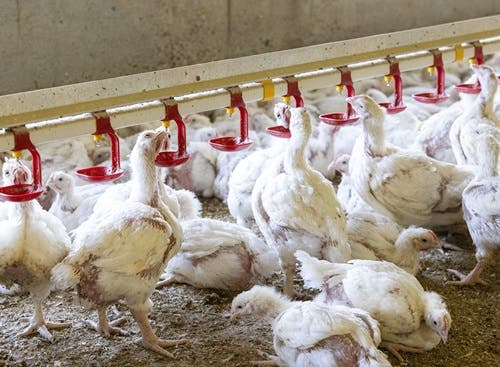What causes necrotic enteritis in poultry?
Necrotic enteritis is one of the most economically important intestinal diseases that can affect broiler chickens.
In its clinical form, it can cause up to 30% mortality in infected flocks1,2,3, however, sub-clinical cases can be an issue because they result in poor feed efficiency – and in turn, financial losses.
Estimates suggest sub-clinical necrotic enteritis costs the global industry between £1.5 billion and £4.6 billion every year due to production losses and the cost of control measures4.
This article explains the causes of necrotic enteritis in poultry and how it can be treated.
What causes necrotic enteritis in poultry?
Necrotic enteritis is caused by Clostridium perfringens – a naturally occurring bacteria in the bird’s gut.
In normal conditions, the bacteria exists in low numbers and causes no harm to the bird.
However, when the balance of the gut microbiota is disrupted, it can lead to an increase of bacteria that can multiply quickly and produce toxins – leading to necrotic enteritis.
Several factors make birds predisposed to necrotic enteritis. These include:
Predisposing factors
- Coccidiosis: One of the most significant risk factors, coccidiosis causes damage to the intestinal lining, which creates the ideal environment for Clostridium perfringens to flourish. Effective coccidiosis control is therefore key to preventing necrotic enteritis.
- Diet: Poultry diets high in non-starch polysaccharides – such as wheat, barley, and rye – or high protein content, can increase the amount of undigested feed available in the gut, which feeds the Clostridium perfringens bacteria. Sudden changes to diet also disrupt the normal gut microbiota and allow harmful bacteria to multiply.
- Environmental stressors: Overcrowding, poor litter management, and high levels of humidity weaken the immune system1 and increase the likelihood of intestinal diseases, such as necrotic enteritis2.

What are the symptoms of necrotic enteritis in poultry?
Most cases of necrotic enteritis occur when birds are two to six weeks old, and the disease has both clinical and sub-clinical effects.
Although clinical cases are associated with high mortality rates, sub-clinical cases often go unnoticed and have a great economic impact on flocks.
Symptoms include:
Clinical symptoms
- Decreased feed and water intake
- Watery or bloody diarrhoea
- Sudden death, especially in young birds
- Depression and lethargy
- Dehydration and rapid weight loss
- Distended abdomen in severe cases
Sub-clinical symptoms
- Decreased flock performance with no obvious signs of illness
- Reduced feed conversion efficiency
- Poor growth rates
- Mild diarrhoea
How to treat necrotic enteritis in broiler birds
There are several options for treating necrotic enteritis in broiler chickens.
- Preventing coccidiosis: Both products work to control coccidiosis, which is caused by Eimeria parasites that damage the bird’s intestinal lining. By preventing this damage, they stifle the growth of necrotic enteritis-causing bacteria, Clostridium perfringens.
- Creating a healthy gut: By preventing coccidiosis and the growth of harmful bacteria, both products improve Intestinal Integrity – something that is essential for preventing disease.
Learn how these products work inside the bird - watch our video here.
- Van Immerseel, F. et al., Trends Micro 2009 32 (v1.0)
- Gharib-Naseri, K., Poultry Science 2019 6422 (v1.0)
- Bae, D., Poultry Science 2021 302 (v1.0)
- Timbermont, L. et al., Avian Pathol 2011 341 (v1.0)
- Moore, R.J., Avian Pathology 2016 275 (v1.0)
- Tsiouris, V., Avian Pathology 2015 59 (v1.0)